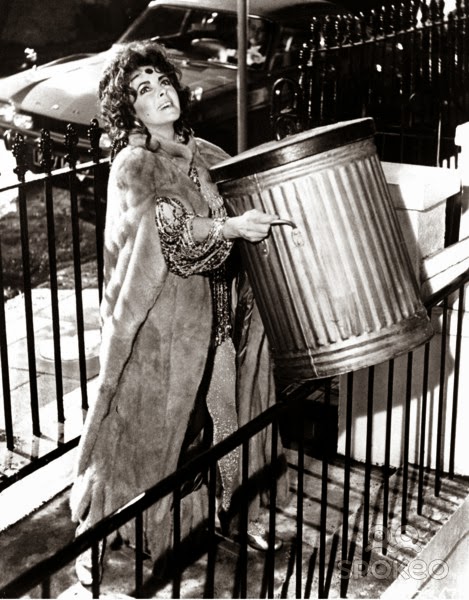Marilyn Monroe described her hometown of Hollywood as “a place where they’ll pay you a thousand dollars for a kiss, but fifty cents for your soul.” This cutting melodrama from 1955 confirms the actress’s rueful analysis of the film industry.
Based on a play by Clifford Odets, obviously embittered by his own experience writing for the Dream Factory, The Big Knife gives viewers a lurid look behind the curtain at what life is really like for those in the movie business. Director Robert Aldrich, adept at revealing the seamy underside of show business’s squeaky clean veneer in films like Whatever Happened to Baby Jane, The Killing of Sister George and The Legend of Lylah Clare, is clearly in his element here.
 |
| A movie idol indulges his appetites |
Here is a Hollywood where stars’ vices are indulged and whims acceded to--then their weaknesses and peccadilloes are carefully exploited for maximum benefit to the bottom line.
Gossip, innuendo and scandal are used strategically by studios to protect their investments,
and cover stories and disinformation are manufactured at a greater pace than the motion picture commodity itself. Illusion creates perception, and perception is reality in the hall of mirrors known as Hollywood.
 |
| Jack Palance as Charlie Castle |
In The Big Knife, movie star Charlie Castle’s soul has been stained, his talent wasted and his marriage nearly destroyed under his seven-year slave contract at Hoff Federated Studios. When it comes time to sign on for another seven years of indentured servitude, he hesitates. But the industry’s well-oiled machine literally chews him up and tears him to shreds when he tries to buck the system.
With his unconventionally handsome features and tall, well-muscled physique, he-man Method actor Jack Palance is well cast as conflicted matinee idol Charlie Castle. Palance, usually most at home playing a menacing bad guy (Sudden Fear, Panic in the Streets), reveals raw and real vulnerability as the wounded idealist faced with a horrifying reality.
 |
| Ida Lupino as Marian Castle |
Film noir heroine Ida Lupino (Out of the Fog), approaching the then-career-halting age of 40, enjoys one of her last roles as a leading lady (before enjoying a second career behind the camera as a film director), displaying a quiet strength as the dissolute movie hero’s long-suffering wife Marian.
A strong supporting cast brings to life a host of juicy archetypal roles. The great Rod Steiger is the personification of narcissistic evil as the domineering studio head Stanley Hoff. Wendell Corey (Harriet Craig) is perfect as the grim-faced studio henchman “Smiley” McCoy, as is Ilka Chase as a vicious and demanding gossip columnist, a la Hedda Hopper or Louella Parsons. Everett Sloane is effective as Castle’s sympathetic but ultimately impotent agent. The versatile Jean Hagen (in a 180º turn from dizzy Lina Lamont in Singin’ in the Rain) scores in her scenes as a slutty, amoral Beverly Hills housewife; her nymphomaniacal character might have been drawn by Harold Robbins, Joyce Haber or Jackie Collins.
 |
| Cuckold Buddy Bliss (Paul Langton) and wife Connie (Jean Hagen) |
 |
| Rod Steiger as Stanley Shriner Hoff |
 |
| Wendell Corey as Smiley McCoy |
 |
| Charlie and Nat (Everett Sloane) |
Shelley Winters (inexplicably billed as Miss Shelley Winters) makes the most of her one-scene cameo as Dixie Evans, a vengeful, addle-pated and overripe starlet who threatens to blow the lid off a scandalous Hoff Federated cover-up. Making Dixie the dumbest of dumb blondes, just a bit long in the tooth and a tad too voluptuous, seems to be a not-too-subtle poke at Winters’s real-life friend Marilyn Monroe, who was waging a battle royale with her own studio around this time.
 |
| (Miss) Shelley Winters as Dixie Evans |
Though the Odets play has been opened up to include short scenes at Castle’s Malibu beach house, the Hoff Studio and a nearby Bel Air cocktail party, this is mostly a filmed stage play, but director Aldrich keeps the action moving with his talented cast and always-inventive camera work. Aldrich’s final tableau of Marian sobbing “Help” as the camera pulls up and back from the scene foreshadows the last shot of The Killing of Sister George a dozen years later.
This voyeuristic peek at Hollywood’s dark side is as sizzling and relevant today as it was 50 years ago. I don’t usually recommend remakes, but an updated version of this conspiracy-driven tale set in the present day and starring a Tom Cruise or even a Mel Gibson, would be fascinating to watch.






















